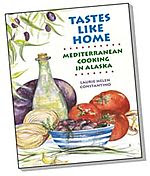I’m just back from Seattle, where my sister lives and my mom has resettled. After her crazy awful 2009 (husband of 65 years died, sold her home of 50 years, moved to a small apartment in a new city), my mom is positively engaged in her new life. Her motto: “Choose Happiness.” My mom, always quirky but never boring, is an inspiration.
Regular readers know nothing makes me happier than cooking with my sister. A couple days into the visit, we dished up a delicious dinner of salmon and lentils with red wine sauce. The food was beautiful; my sister suggested I take a picture and blog the meal (another day, I promise). I was too hungry for photography.
Over dinner, my sister claimed it was traditional for me to blog about one meal cooked in her kitchen each visit. Who knew? It’s funny how traditions sneak into your life without warning. And ignoring tradition, even one newly adopted, is bad juju. So that night, I found myself lying in bed dreaming up recipes.
At the store, we’d just bought chickpeas and gorgeous lamb steaks. My sister was out of coriander, so we'd bought some of that too. I decided to pair the chickpeas and coriander in a stew with plenty of fresh mint. The next day we went to Big John’s PFI, a Seattle store with a great cheese selection, and bought Greek sheep feta (and, of course, much more), the perfect finishing ingredient for chickpea stew.
Sadly, the Seattle stew pictures didn’t turn out (bad lighting, no tripod), so I “forced” myself to remake the stew when I returned to Alaska. Since I’d been craving leftover chickpeas during the foodless flight home, I was quite happy to make them again, especially because the stew goes together so quickly. It was as tasty the second time as it was in Seattle. This time, I ate the leftovers, and the flavor, already great, was even better the next day.
With generous quantities of mint, my chickpea stew goes particularly well with lamb. It also makes a deliciously filling meal on its own. The recipe has definitely been added to my permanent rotating repertoire.
Serves 4
Serve as a side dish with grilled lamb or chicken, or as a main course with steamed rice or couscous. A crisp green salad nicely completes the meal.
3 cups diced yellow onions, 1/4” dice
Salt
Freshly ground black pepper
1/4 cup olive oil
1 cup diced carrots, 1/4” dice
1 cup diced celery, 1/4” dice
1 Tbsp. minced garlic
2 tsp. ground coriander
1 tsp. crushed red pepper flakes (optional)
2 14.5-oz. cans diced tomatoes
3 1/2 cups cooked chickpeas or 2 15-oz. cans, rinsed and drained
1/2 cup minced fresh parsley
1/2 cup minced fresh mint
1 1/2 cups crumbled feta
Sauté the onions, lightly seasoned with salt and freshly ground black pepper, in olive oil until they soften and start to turn golden. Stir in the carrots and celery and sauté for 5 minutes. Stir in the garlic, ground coriander, and crushed red pepper flakes and cook for 1 minute. Stir in the tomatoes and chickpeas and bring to a boil. Cover, turn down the heat, and simmer for 45 minutes, or until the sauce thickens and the flavors meld. Stir in the parsley and mint and cook for 5 minutes. Stir in the feta and serve immediately.
~~~~~~~~~~~~~~~~~~~~~~~~~~
This is my entry for Weekend Herb Blogging hosted this week Katie from Eat This.






 Assuming the weather holds, there are two more Saturday Farmers’ Markets this year in Anchorage: October 10 and October 17. Last week the tables were well-stocked with a wide array of vegetables; our purchases included lime-green
Assuming the weather holds, there are two more Saturday Farmers’ Markets this year in Anchorage: October 10 and October 17. Last week the tables were well-stocked with a wide array of vegetables; our purchases included lime-green 


